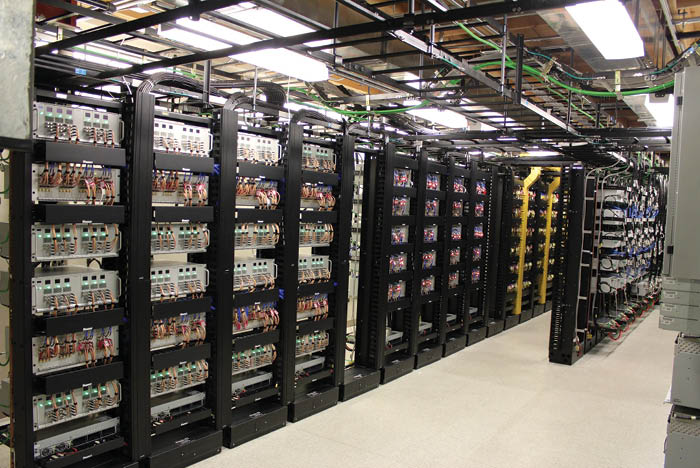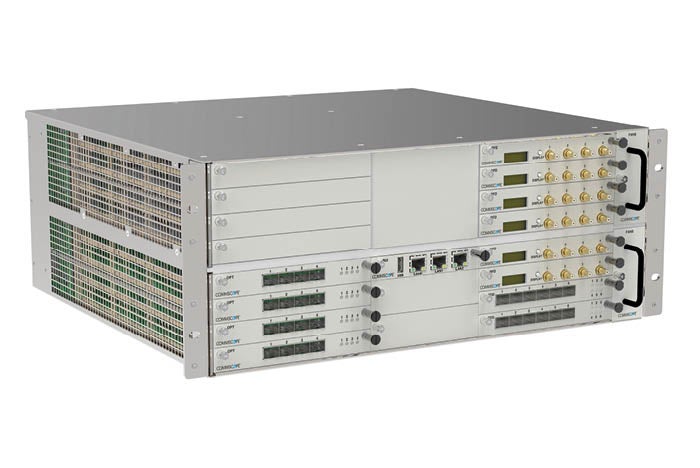The future of wireless connectivity

The advent of 5G and Wi-Fi 6 can help health care facilities provide faster speeds and multiple application use as end user growth continues to expand.
Image by Getty Images
With rapid growth in wireless demand continuing to explode over the next five years, planning for the future of wireless starts now.
Fifth-generation (5G) wireless is the latest advancement in wireless technology. 5G wireless is exponentially faster, but how it achieves that speed is different than prior generations. The increase in speed and decrease in latency creates new possibilities for transformation and innovation in patient care.
But 5G may also mean a health care facility must be planned or upgraded to an entirely different infrastructure. Facilities should be developing a technology strategic plan now for upgrading or replacing current wireless infrastructure to support 5G in the future.
A fourth utility
For good reason, wireless connectivity is often called “the fourth utility.” Smartphones and “connectedness” are now a way of life. That expectation of connectedness does not end at the doors of a hospital. Patients, families, staff and, especially, doctors want and often expect to have fast access to wireless service, on-demand video streaming and a bevy of personalized applications.
All that voice-data-internet convergence takes a lot of bandwidth. Major wireless providers are constantly upgrading their networks to add frequencies and technologies to rise to seemingly insatiable demands for mobile data. Both facility owners and cellular providers have been challenged with keeping up with the rapid growth and need for increased throughput at the mobile level.
Mobile or cellular networks were introduced in the 1970s, but it was not until the 1990s that 2G service was introduced. It improved voice traffic quality but only provided limited data service. Audio, graphics and video applications were not possible until 3G.
The current generation of mobile telephony (4G) is a series of measures that defines the demands of a 4G network and the standards that must be met; for example, a common standard specifies a 4G network as one that offers 100 megabits per second (Mbps) for devices on the move.
In only six years, consumption of 4G data has grown by 25 times. This evolution has not always been easy and often has required costly rip and replace of both infrastructure and electronics, as the need to adopt new methods and technologies have emerged.
Implementation of 5G is still in early deployment but is expected to provide speeds 10 times faster than 4G and perhaps up to a peak of 20 gigabytes (GBs) per second to the user element (e.g., phone), be more reliable and accessible, and probably more expensive.
Recent 5G testing in initial cellular rollouts are reaching nearly 300 Mbps. With the rise in speed comes a denser network of antennas. In utilizing millimeter wave (mmWave), the density of small cells will drastically increase and have trouble passing through some types of building walls. Cellular carriers have started rolling out 5G service to select cities and will continue comprehensive rollout plans.
In addition to advances in mobile technology has been Wi-Fi capability. Wi-Fi 6 is the newest generation of Wi-Fi connectivity supporting 802.11ax technology. Like 5G, Wi-Fi 6 is an effort to support multiple user devices, the “internet of things” and higher data rates. While 5G and Wi-Fi 6 have different technology implementation requirements, the end goal is to provide gigabit wireless ethernet to users.
Benefits of 5G
The benefits of 5G and Wi-Fi 6 may extend beyond watching videos on a phone while a person is a visitor to the med-surg unit. Just as the internet of things continues to grow exponentially, the internet of medical things (IoMT) may experience a breakthrough due to 5G and Wi-Fi 6.

The fiber-based DAS remote enclosure device provides fiber to the remote unit to support cellular and ethernet connectivity for edge IT devices, such as DAS antennas, wireless access points and internet protocol cameras.
Image courtesy of CTS
There is great potential for medical equipment devices manufacturers and hospital owners to find ways to use the bandwidth, reliability and low latency of these two technologies to dramatically improve health outcomes, especially for chronic disease patients, including the elderly.
Regular check-ups that require scheduling, travel for the patient and imperfect data (e.g., episodic and self-reported by the patient) could be replaced with constant streams of remote monitoring data that is more accurate and that can reveal trends, patient compliance and efficacy of treatment over time.
Other opportunities for better patient care include ambulances that stream video of the patient to the emergency department physician while en route, enabling better treatment. The capabilities of telemedicine will expand due to better quality video and better data. Even something as simple as transferring a magnetic-resonance imaging study from the outpatient imaging center to the physician at the clinic or hospital will become almost instantaneous, expediting diagnosis and communication with the patient.
The use of 5G could enable the truly “smart” hospital to emerge. The smart concept will include the use of internet of things and IoMT devices as they have been designed. Instant feedback, streamlined workflow and enhanced patient care are just a few areas where IoMT can benefit from 5G-type speeds.
Latency is one of the big advantages of higher data rates. With 4 milliseconds (ms) being the standard for 5G, having the ability to send and receive data with basically instant update could change the way systems and software applications are developed and implemented.
Data will be the key to most health care advances over the coming years. Having the ability to generate tons of data in real time allows for preventive care and analytic capabilities.
Another benefit of low latency is the ability to transmit large files quickly. Imagine being limited to the transmission of files from hospital to outpatient facilities or clinics due to network constraints. Now, files that could be as large as 1 GB per patient can be sent to specialists for quicker review, in turn improving the overall quality of care for the patient. Improved connectivity will help ensure timely transmission of these large files.
Wearables are another area of potential real-time monitoring for patients. Wearable health monitoring devices are used by 70 million people in the United States. With 86% of doctors saying wearables increase patient engagement and the ability of wearables to reduce hospital costs, this could have an immediate impact.
Telemedicine also is an area that could see great improvement with the rollout of 5G and Wi-Fi 6. Its growth should coincide well with more mature 5G networks. Rural locations could have access to specialists that were previously unavailable.
Infrastructure implications
Building wireless solutions and the implementation of 5G and Wi-Fi 6 supports the need for wireless connectivity and improves the patient experience within the health care facility, thus providing higher levels of satisfaction with caregivers and facilities.
Different from Wi-Fi 6, 5G technology is cellular based and operates in specific blocks of the wireless spectrum. While it’s possible for 5G to run on unlicensed bands, interference between Wi-Fi and cellular technologies should be evaluated inside of health care facilities.
The best way to alleviate interference is to install an in-building wireless system, often referred to as distributed antenna system (DAS). There are multiple types of DAS technologies, including fiber-based, cloud-based, carrier-funded and hybrid fiber/coaxial.

Planning for the cellular provider headend, such as this one for a large fiber-based DAS installation, is key to wireless infrastructure design.
Image courtesy of CTS
Most of these have been vetted and perform reliably with current 4G cellular technology. There are even cases of migrating telemetry onto this infrastructure as well. With the advances of 5G and its requirements, a DAS system should be considered as a critical part of a hospital’s cabling infrastructure.
With the variety of cellular carriers in the marketplace across the country, most DAS implementations in health care should consider multi-carrier DAS systems. Installing separate DAS infrastructure for separate carriers should be avoided. This will allow the health system to control operation and future upgrades of the DAS system without needing to rip and replace infrastructure.
All-fiber DAS includes the cable infrastructure that is possibly best suited to support future 5G requirements in building spaces. There are several benefits to a fiber-based solution. The capacity and low latency of fiber to the edge to support DAS equipment could allow 5G to be supported within its current infrastructure. Fiber cabling is utilized for both riser and horizontal infrastructure. Horizontal fiber is routed to a fiber remote access unit that supports wireless frequency bands.
Hybrid fiber/coaxial is one of the most common DAS cable infrastructures and supports many existing health care facilities. Hybrid fiber/coaxial DAS utilizes fiber riser cable and coaxial horizontal cable to the DAS antennas. Based on the pure density that could be required with 5G, any existing deployments will more than likely require a substantial upgrade to repeat 5G frequencies throughout the building.
Overall, 5G is still taking shape. Major original equipment manufacturers will support 5G protocol. Edge DASs would perform better than hybrid fiber coaxial, but significant infrastructure will be needed to get to true 5G-gigabit throughput.
Voice over Wi-Fi (VoWi-Fi) is another potential in-building wireless solution that utilizes the Wi-Fi infrastructure for cellular-based calling. VoWi-Fi could be an option for hospital-deployed wireless devices (e.g., nurse handsets) because these do not require cellular connections and can provide E911 location-based services as well. One of the main considerations is to ensure the validation and testing of the Wi-Fi network as a whole. In general, Wi-Fi networks will make or break a health care facility’s device implementation plan.
Depending on the size and scope of the health care facility, small cells may also be used to provide 4G/5G infrastructure. Small cells can supplant or be a complementary technology to DAS. They can be used as a radio frequency (RF) source to a DAS or as self-contained single carrier solutions.
There are a variety of sizes of small cells used outdoors and indoors. They may also be used for technologies such as citizens broadband radio service (CBRS)/private long-term evolution (LTE), license-assisted access (LAA) and FirstNet. Small cells help carriers augment their macro network capacity. They offer advantages over DAS but, generally, DAS is better at addressing multicarrier 4G/5G applications in a sizeable acute care location.
The transition from 4G to 5G wireless frequency will require an enterprise-, system- and building-level evaluation of any existing DAS deployment. The need for low latency and speed will require deep evaluation of all hospital cable infrastructure to provide multiple levels of support for wireless technologies.
Factors to consider
Planning considerations for health care facilities professionals include infrastructure changes as well as the importance of establishing quality of service protocols. For example, the move to 5G capability will require fiber deeper into networks than ever before due to latency and capacity demands.

DAS systems that can support any cellular carrier with in-building coverage allow for future mobile device management and planning.
Image courtesy of Commscope
Understanding the infrastructure options and requirements to support full-scale wireless deployment via Wi-Fi and/or DAS is a critical step in developing the initial strategic plan and facility vision. As discussed previously, each DAS technology has different infrastructure requirements and ability to potentially support new wireless technology in the future.
Baseline measurement requirements are another area to confirm. In addition to better latency and greater capacity demands, 5G is likely to require support for mmWave, 5.9 gigahertz (GHz) (LAA) and 3.5 GHz (CBRS). Understanding the pros and cons and design considerations for private LTE and CBRS as a DAS replacement strategy is another key component.
While considering baseline measurement requirements, the type of building must also be evaluated. With buildings becoming more energy efficient by the building material itself, some new, efficient building materials attenuate wireless signals from the outside of the building affecting indoor coverage and capacity.
Planning for the future is a critical step to the overall technology strategic plan. Every facility wants a future-proof design. Providing a future-ready building is more realistic. Costs, particularly the total cost of ownership, need to be understood and evaluated.
The strategic plan can revolve around internal facility strategic initiatives (e.g., improved patient engagement and Lean practices). Having a wireless strategy and infrastructure in place that can support and grow with the facility strategic initiative is key for overall project and continued success.
Wi-Fi and DAS should be considered as coexistent infrastructure to allow for maximum flexibility and growth.
With any technology that allows internet of things and IoMT devices connected to the network, security concerns will arise. As with any strategic plan, a security evaluation should also accompany each decision along the way. Given the amount of data and devices set to connect and transmit across the health care facilities network, patient confidentiality and data security are top concerns.
Planning wisely
Technology advances in combination with 5G and Wi-Fi 6 wireless infrastructure development have the potential to provide important connectivity benefits to patients and families as well as physicians and staff.
Planning wisely for these advances now with an understanding of wireless infrastructure is important in the short term as well as in the future.
Josh Kelly, RCDD, is associate principal at Ross & Baruzzini | EDI, Atlanta. He can be reached at jkelly@rossbar.com.




